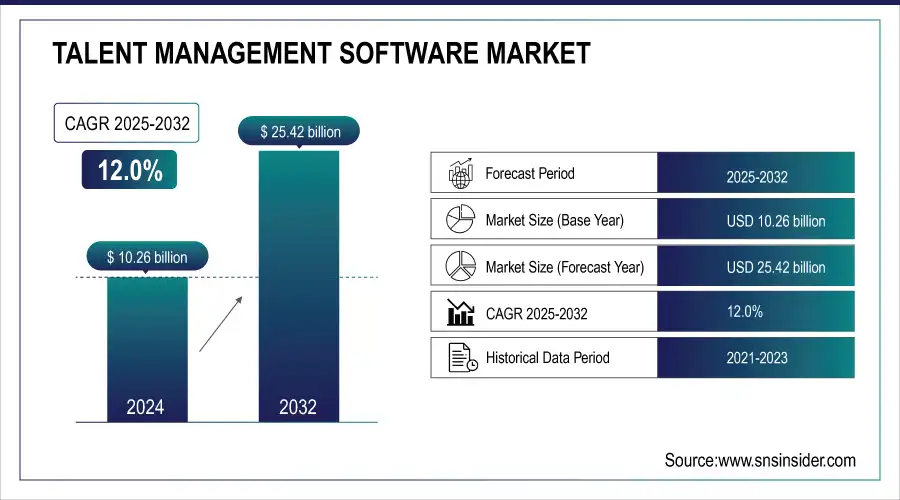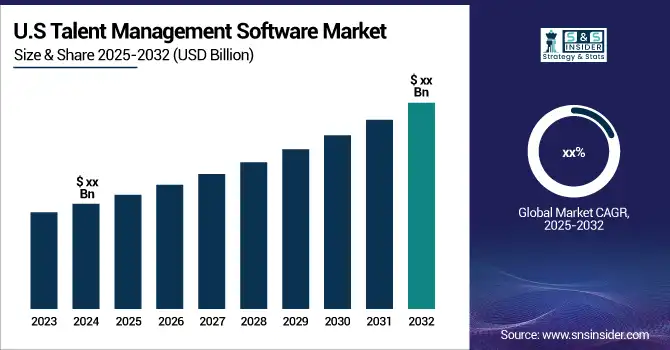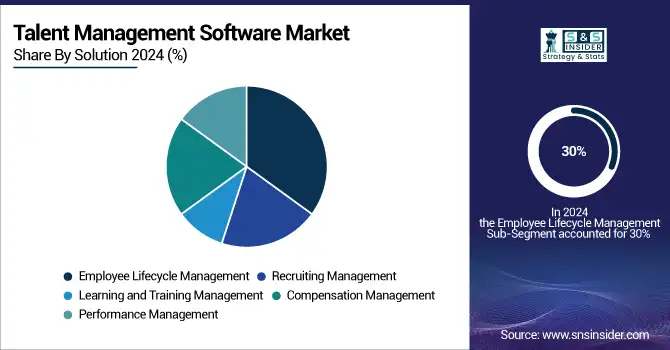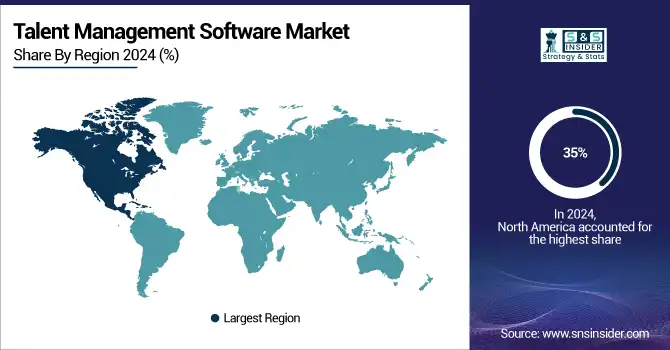Talent Management Software Market Report Scope & Overview:
The Talent Management Software Market size was recorded at USD 10.26 billion in 2025E and is expected to reach USD 25.42 billion by 2033, growing at a CAGR of 12.00 % over the forecast period of 2026-2033.
Market Size and Forecast:
-
Talent Management Software Market Size in 2025E: USD 10.26 Billion
-
Talent Management Software Market Size by 2033: USD 25.42 Billion
-
CAGR: 12% from 2026 to 2033
-
Base Year: 2025E
-
Forecast Period: 2026–2033
-
Historical Data: 2022–2024

Get more information on Talent Management Software Market - Request Sample Report
Talent Management Software (TMS) Market is seeking a major overhaul with plenty of new technologies breaking through the workspace of workforce management in an organization till cloud and data analytics are doing most notably well. The rapid transition to web-based applications and digitalization are the primary factors driving demand for software solutions, while how quickly talent management technologies can be adopted among various industries will also drive more advanced tools into the Talent management software market. The Review by the Recruiters about the use of software for recruitment has admitted that more than 60% of the companies have shifted to AI/ ML for skill assessment. Moreover, In Fortune 500 Companies, more than 90% of the companies Using ATS (AI software) to recruit, as well as more than 65% of the Large Companies use AI, which results in as cost-effective and time saver for them.

Key Talent Management Software Market Trends
-
Growing adoption of cloud-based talent management solutions for scalable and flexible workforce management.
-
Increasing use of AI and machine learning for predictive analytics, performance evaluation, and personalized employee development.
-
Rising focus on employee engagement, retention, and experience driving demand for integrated HR tech platforms.
-
Expansion of remote work and hybrid models boosting need for digital talent management tools.
-
Growing integration of talent management software with payroll, recruitment, and learning management systems.
-
Increased adoption of mobile-enabled solutions for real-time access to HR data and employee self-service.
-
Rising emphasis on diversity, equity, and inclusion (DEI) initiatives supported by analytics-driven talent insights.
-
Demand for succession planning and leadership development modules to address skill gaps and future workforce needs.
-
Adoption of gamification and performance recognition features to enhance productivity and engagement.
-
Integration of compliance management and workforce analytics to support strategic HR decision-making.
Talent Management Software Market Growth Drivers
-
Increasing Market Potential by simplifying the Hiring Process with Technological Innovations
The increasing adoption of cloud-based platforms and mobile-based personnel management systems are some other factors driving the growth in the talent management software market. SaaS implementations are increasingly becoming common in organizations and among HR professionals where scouting, identification, and recruitment of new talent from talent pools along with retaining the existing personnel is being automated through SaaS-based platforms. Talent management software such as ADP Workforce, Zip Recruiter, Talent 3Sixty, LinkedIn, Workday, and ORACLE TBE, can also improve the hiring process, reinforce office culture, and help employees learn in a place that suits those best through digitizing workforces for enhanced performance. These advances are seamlessly incorporated and integrated into other mobile apps, due to the interworking with social media tools, which collectively drive more utilization of talent management software. The economy has also increased due to various technical breakthroughs such as Machine Learning (ML) and artificial intelligence (AI). For Instance, TalentGuard, WorkforceGPT, Is a brand new program launched in March 2023 that uses cutting-edge technology to help businesses manage their employees in a whole new way.
Talent Management Software Market Restraints
-
SMEs' lack of awareness of talent management software solutions will stymie market growth.
Although data and analytics have long been used to make informed business choices, most organizations still have a long way to go in terms of using talent analytics. A big obstacle to market expansion is a lack of knowledge, of the benefits of talent management software. To map competence needs at all levels of the organization, talent management requires the use of expensive instruments. Due to a Lack of funding, Small and Medium Enterprises are hesitating to invest in this software. As a result, SMEs see limited adoption of talent management technology.
Talent Management Software Market Opportunities
-
Increasing AI in Human resource management creates opportunities for the market.
Growing integration of artificial intelligence in human resource management is creating significant opportunities for the Talent Management Software market. AI enhances various HR functions such as recruitment, performance evaluation, employee engagement, and workforce planning. With AI-driven analytics, companies can identify skill gaps, predict employee turnover, and make data-backed decisions. Automation of repetitive tasks improves HR efficiency, while personalized learning and development paths boost employee productivity. As organizations adopt advanced HR technologies, the demand for intelligent talent management solutions continues to rise.
Talent Management Software Market Segmentation Analysis
By Solution, Employee Lifecycle Management Leads the Market in 2025 Driven by Rising Focus on Engagement and Retention.
In solution-type segmentation, employee lifecycle management led the market with more than 30% of the market share in 2025, due to an increasing shift toward employee engagement and taking actions toward retaining the employees in the workplace. According to the U.S. market report on the attraction and retention rate of employees, up to May, 24 the no. of employees seeking new jobs is seen to be more than 45%. Companies nowadays are taking effective steps such as creating diverse work cultures, providing hybrid modes of working, rewarding efforts, etc. For Instance, in the U.S., companies are adopting 4 days work culture, with many countries like Australia, Austria, and Canada already following this, which boosts the company's reputation.
Moreover, companies are also paying for training employees so that they can give their best towards company and get attached to the organization for long. Software such as SkyPrep, Deel, WeSchool, and Leapsome are some, used by companies to train the employees.

By Deployment, Cloud-Based Talent Management Solutions Gain Momentum as Companies Streamline Hiring and Reduce Time-to-Hire.
The growing adoption of cloud-based solutions by companies to reduce their time and effort from job posting to sorting the right candidates, scheduling interviews, and so on. This also reduces their time by almost 50% and also sorts the candidates with the right skills. For Instance, the software is Manatal, Zoho Recruit, jazz HR, etc.
Talent Management Software Market Regional Analysis
North America Talent Management Software Market Insights
North America region led the market of the talent management platform market with more than 35% of the market share during the forecast period. The Market survey on talent management suggests that North America is a mature market for talent management, core HR, and recruitment technologies. The regional market is dominated by established HCM software suppliers, especially Ceridian HCM Holding Inc., Oracle Corporation, IBM Corporation, and others.
According to a market survey with HRs in North America in 2025, more than 75% of companies are using AI for recruitment and also investing heavily in that. In Addition, more than 40% Of HRs use ATS scores (by ATS +AI software) to shortlist the candidates. According to SNS research, the adoption of AI in recruitment has reduced the cost by 40% for companies as compared to traditional Methods.

Need any customization research on Talent Management Software Market - Enquiry Now
Asia Pacific Talent Management Software Market Insights
Asia-Pacific anticipated registering a significant growth rate, as organizations becoming more comfortable with new technologies may be the primary reason for market growth. The growing need for products in developed countries is one of the substantial reasons among others propelling the demand for organizational management technologies. Because of its vibrant ecosystems, Japan and India will also be key markets for the application of SMEs to encourage its adoption. Conversely, large clients belonging to sectors such as IT & telecom, BFSI, manufacturing, and education are expected to provide major dollars.
Europe Talent Management Software Market Insights
The Europe Talent Management Software Market is witnessing steady growth in 2025, driven by increasing digitalization in HR processes, rising adoption of cloud-based solutions, and growing emphasis on employee engagement and performance management. Key markets such as the U.K., Germany, and France are investing in AI-enabled analytics, learning management systems, and recruitment automation. Moreover, the focus on diversity, equity, and inclusion (DEI) initiatives, along with regulatory compliance in labor practices, is further propelling the demand for integrated talent management solutions across the region.
Latin America (LATAM) Talent Management Software Market Insights
The LATAM Talent Management Software Market is expanding gradually in 2025, supported by growing organizational adoption of digital HR tools and increasing awareness of workforce productivity optimization. Countries like Brazil, Mexico, and Argentina are leveraging cloud-based and mobile-accessible solutions for recruitment, performance evaluation, and employee engagement. Government policies promoting workforce development and investments in corporate training programs are also stimulating market growth. The rise of remote working and flexible work arrangements is further accelerating the adoption of talent management platforms across enterprises.
Middle East & Africa (MEA) Talent Management Software Market Insights
The MEA Talent Management Software Market is gaining momentum in 2025, driven by rapid economic diversification, workforce modernization, and rising adoption of cloud and AI-powered HR technologies. Countries such as the UAE, Saudi Arabia, and South Africa are increasingly investing in digital solutions for recruitment, performance management, and learning & development. Regional focus on talent retention, upskilling, and workforce planning, along with initiatives to attract global talent, is further enhancing the demand for comprehensive talent management software across both public and private sector organizations.
Talent Management Software Market Competitive Landscape
Talent Tech Labs
Talent Tech Labs is a technology company providing talent management software solutions for human resources and workforce optimization.
-
In February 2024, Talent Tech Labs introduced a software update to assist HR departments with employee management. The update includes the latest tools and features designed to streamline recruitment, performance evaluation, learning, and development processes, helping HR teams operate more efficiently and enhance workforce productivity.
Mercer | Mettl
Mercer | Mettl is a global provider of online assessment, talent management, and HR technology solutions.
-
In February 2024, Mercer | Mettl released an update to its talent management platform, incorporating advanced analytics and AI-driven features. The update aims to help HR departments better track employee performance, improve engagement, and optimize workforce planning while providing actionable insights for strategic decision-making.
Talent Management Software Market Key Players
-
IBM Corporation
-
BambooHR LLC
-
SAP SE
-
Haufe Group
-
Lumesse AS
-
DelTek, Inc.
-
Applied Training Systems, Inc.
-
Saba Software, Inc.
-
Halogen Software, Inc.
-
ADP, LLC
-
Kronos Incorporated (UKG)
-
Ultimate Software (UKG)
-
iCIMS, Inc.
-
Paycor, Inc.
-
SilkRoad Technology, Inc.
-
SuccessFactors (SAP SE)
| Report Attributes | Details |
|---|---|
| Market Size in 2025E | US$ 10.26 billion |
| Market Size by 2033 | US$ 25.42 Billion |
| CAGR | CAGR of 12.00% From 2026 to 2033 |
| Base Year | 2025E |
| Forecast Period | 2026-2033 |
| Historical Data | 2022-2024 |
| Report Scope & Coverage | Market Size, Segments Analysis, Competitive Landscape, Regional Analysis, DROC & SWOT Analysis, Forecast Outlook |
| Key Segments | • By Solution (Employee Lifecycle Management, Recruiting Management, Learning and Training Management, Compensation Management, Performance Management) • By Deployment(Cloud, On-premise) • By Organization Size(Small and Medium Enterprises, Large Enterprises) • By Application(IT and Telecommunication, BFSI, Government, Healthcare, Education, Manufacturing, Others) |
| Regional Analysis/Coverage | North America (US, Canada), Europe (Germany, France, UK, Italy, Spain, Poland, Russsia, Rest of Europe), Asia Pacific (China, India, Japan, South Korea, Australia,ASEAN Countries, Rest of Asia Pacific), Middle East & Africa (UAE, Saudi Arabia, Qatar, Egypt, South Africa, Rest of Middle East & Africa), Latin America (Brazil, Argentina, Mexico, Colombia Rest of Latin America) |
| Company Profiles | Workday, Inc., IBM Corp., 15Five, Oracle Corp., Cornerstone OnDemand, SAP SE, Peoplefluent; Inc., Haufe Group, Lumesse AS, DelTek Inc., Halogen Software Inc., Saba Software Inc |

